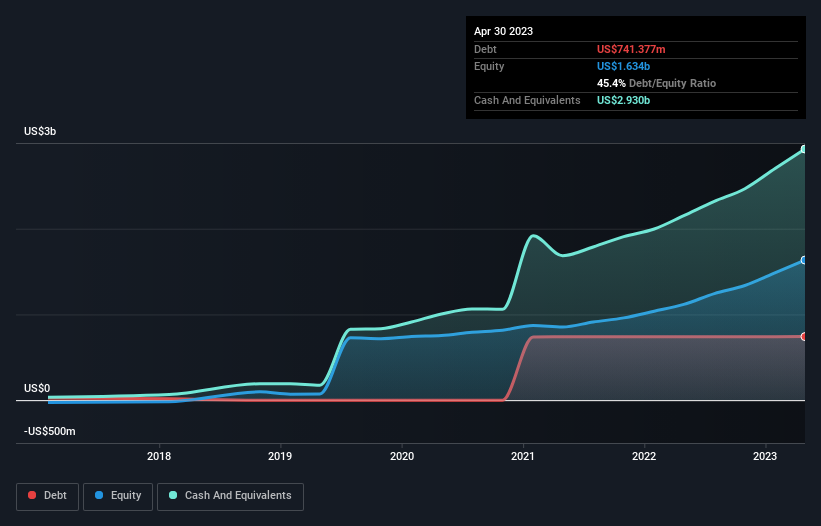Health Check: How Prudently Does CrowdStrike Holdings (NASDAQ:CRWD) Use Debt?
The external fund manager backed by Berkshire Hathaway's Charlie Munger, Li Lu, makes no bones about it when he says 'The biggest investment risk is not the volatility of prices, but whether you will suffer a permanent loss of capital.' So it seems the smart money knows that debt - which is usually involved in bankruptcies - is a very important factor, when you assess how risky a company is. As with many other companies CrowdStrike Holdings, Inc. (NASDAQ:CRWD) makes use of debt. But should shareholders be worried about its use of debt?
When Is Debt Dangerous?
Debt and other liabilities become risky for a business when it cannot easily fulfill those obligations, either with free cash flow or by raising capital at an attractive price. In the worst case scenario, a company can go bankrupt if it cannot pay its creditors. However, a more frequent (but still costly) occurrence is where a company must issue shares at bargain-basement prices, permanently diluting shareholders, just to shore up its balance sheet. By replacing dilution, though, debt can be an extremely good tool for businesses that need capital to invest in growth at high rates of return. When we think about a company's use of debt, we first look at cash and debt together.
Check out our latest analysis for CrowdStrike Holdings
How Much Debt Does CrowdStrike Holdings Carry?
As you can see below, CrowdStrike Holdings had US$741.4m of debt, at April 2023, which is about the same as the year before. You can click the chart for greater detail. But on the other hand it also has US$2.93b in cash, leading to a US$2.19b net cash position.
How Healthy Is CrowdStrike Holdings' Balance Sheet?
According to the last reported balance sheet, CrowdStrike Holdings had liabilities of US$2.08b due within 12 months, and liabilities of US$1.42b due beyond 12 months. Offsetting this, it had US$2.93b in cash and US$461.1m in receivables that were due within 12 months. So its liabilities total US$112.7m more than the combination of its cash and short-term receivables.
Having regard to CrowdStrike Holdings' size, it seems that its liquid assets are well balanced with its total liabilities. So it's very unlikely that the US$35.7b company is short on cash, but still worth keeping an eye on the balance sheet. While it does have liabilities worth noting, CrowdStrike Holdings also has more cash than debt, so we're pretty confident it can manage its debt safely. The balance sheet is clearly the area to focus on when you are analysing debt. But it is future earnings, more than anything, that will determine CrowdStrike Holdings's ability to maintain a healthy balance sheet going forward. So if you're focused on the future you can check out this free report showing analyst profit forecasts.
Over 12 months, CrowdStrike Holdings reported revenue of US$2.4b, which is a gain of 49%, although it did not report any earnings before interest and tax. Shareholders probably have their fingers crossed that it can grow its way to profits.
So How Risky Is CrowdStrike Holdings?
Although CrowdStrike Holdings had an earnings before interest and tax (EBIT) loss over the last twelve months, it generated positive free cash flow of US$745m. So although it is loss-making, it doesn't seem to have too much near-term balance sheet risk, keeping in mind the net cash. One positive is that CrowdStrike Holdings is growing revenue apace, which makes it easier to sell a growth story and raise capital if need be. But we still think it's somewhat risky. When analysing debt levels, the balance sheet is the obvious place to start. But ultimately, every company can contain risks that exist outside of the balance sheet. Case in point: We've spotted 2 warning signs for CrowdStrike Holdings you should be aware of.
At the end of the day, it's often better to focus on companies that are free from net debt. You can access our special list of such companies (all with a track record of profit growth). It's free.
Have feedback on this article? Concerned about the content? Get in touch with us directly. Alternatively, email editorial-team (at) simplywallst.com.
This article by Simply Wall St is general in nature. We provide commentary based on historical data and analyst forecasts only using an unbiased methodology and our articles are not intended to be financial advice. It does not constitute a recommendation to buy or sell any stock, and does not take account of your objectives, or your financial situation. We aim to bring you long-term focused analysis driven by fundamental data. Note that our analysis may not factor in the latest price-sensitive company announcements or qualitative material. Simply Wall St has no position in any stocks mentioned.

 Yahoo Finance
Yahoo Finance 
